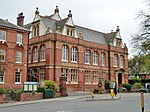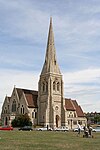Blackheath Quaker Meeting House
20th-century Quaker meeting housesGrade II listed buildings in the London Borough of LewishamGrade II listed religious buildings and structuresInfobox religious building with unknown affiliationQuaker meeting houses in England ... and 1 more
Quaker meeting houses in London

Blackheath Quaker Meeting House is a Grade II listed building in the London Borough of Lewisham. It has been the home of Blackheath Quaker Meeting since 1972, and is also used by many community groups. Designed by Trevor Dannatt, it is believed to be the only Quaker Meeting House in Britain built in the Brutalist style. In the survey of Quaker meeting houses conducted by the Architectural History Practice for Historic England and Quakers in Britain it was described as a "Brutalist jewel" and "of exceptional aesthetic value".
Excerpt from the Wikipedia article Blackheath Quaker Meeting House (License: CC BY-SA 3.0, Authors, Images).Blackheath Quaker Meeting House
Lawn Terrace, London Blackheath (London Borough of Lewisham)
Geographical coordinates (GPS) Address Nearby Places Show on map
Geographical coordinates (GPS)
| Latitude | Longitude |
|---|---|
| N 51.465063 ° | E 0.006968 ° |
Address
Lawn Terrace 2-32
SE3 9LL London, Blackheath (London Borough of Lewisham)
England, United Kingdom
Open on Google Maps







